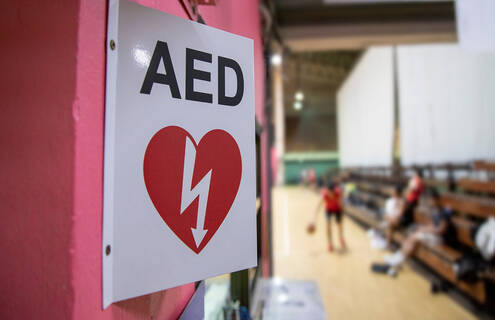
Have you ever wondered about those metal boxes—the ones with a heart and a lightning bolt—hanging on the wall at the airport, in your child's school or at the local mall? They're AEDs (automated external defibrillators) and ready for people like you to save a life in an emergency.
An AED is a portable medical device used to evaluate a person's heart rhythm and, if needed, automatically delivers an electric shock to return the heart to a normal rhythm. After CPR (cardiopulmonary resuscitation), an AED is the most important tool in saving someone's life outside of the hospital.
When to use an AED
An AED can help when a person shows signs of cardiac arrest. The signs of cardiac arrest are:
- A person who is unresponsive with no movement, speech or blinking.
- An unconscious person who is not breathing or is gasping for air.
If someone is in cardiac arrest you should:
- Call for help.
- Have someone dial 911.
- Immediately begin CPR.
- Locate and apply an AED.
AEDs are located on the walls of many public, high-traffic areas and are commonly found in hallways, lobbies, dining areas, and near elevators. Some organizations, like recreational sports leagues and commercial gyms, may have portable AEDs on hand. An off-duty first responder may be nearby and have one. So even if you aren't in a physical building, always call out to check if someone has one.
Don't be afraid to use an AED even if you don't know how. The device is designed to provide visual and verbal instructions for use. You won't shock someone unnecessarily because the AED detects whether or not it's needed. It will only shock a person if it's appropriate. If a shock is needed to restore the heart's rhythm, the AED will tell bystanders to step back and will then deliver the shock. If a shock is not necessary, continue to perform CPR until help arrives.
Even though you can use an AED without training, it's best to learn how before finding yourself in an emergency situation. Learning materials and training options are available on the American Heart Association website or sign up for a local CPR/AED training course.
According to the American Heart Association, a person's chance of surviving a cardiac arrest drops by 7% to 10% every minute a normal heartbeat isn't restored. Remember, the most important thing to do if you find someone in cardiac arrest is to perform CPR as soon as possible. CPR and AED use can double—or triple—the person's chance of survival.
To learn more about CPR and AED use, visit the American Heart Association website.
This article was reviewed by Kevin F. Kwaku, MD, PhD, Cardiovascular Medicine, Dartmouth Hitchcock Medical Center and Dartmouth Hitchcock Clinics Heart & Vascular Center.